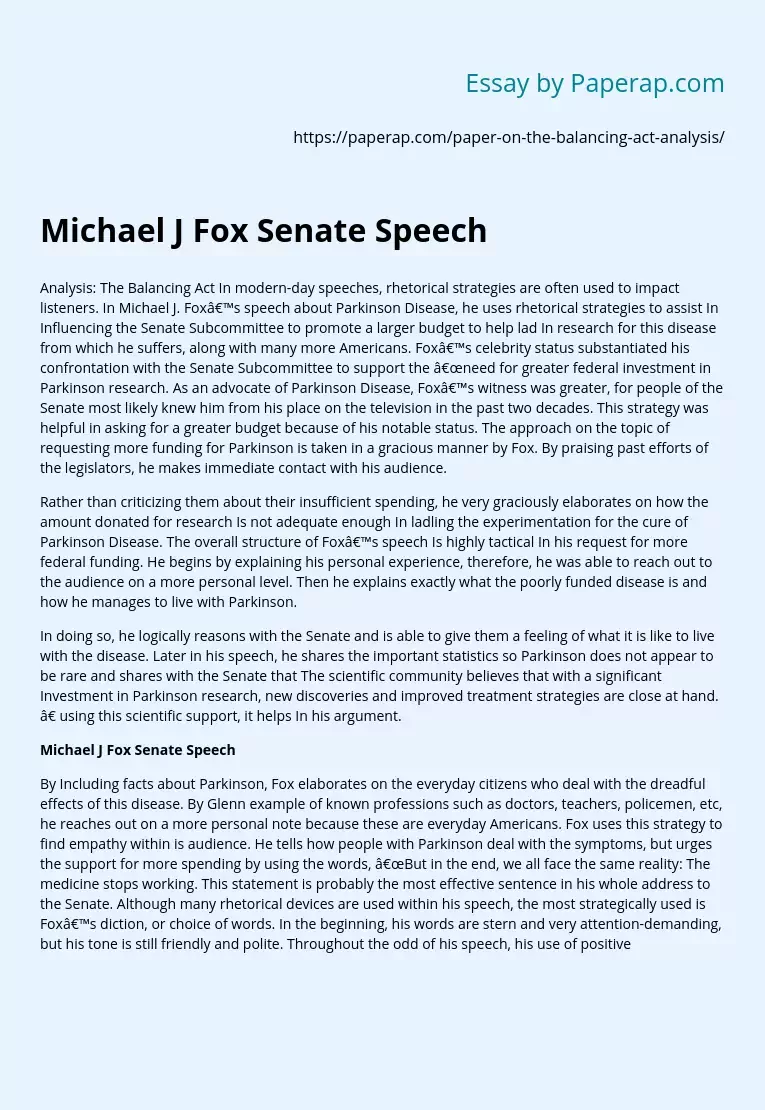Michael J Fox Senate Speech
Analysis: The Balancing Act In modern-day speeches, rhetorical strategies are often used to impact listeners. In Michael J. Fox’s speech about Parkinson Disease, he uses rhetorical strategies to assist In Influencing the Senate Subcommittee to promote a larger budget to help lad In research for this disease from which he suffers, along with many more Americans. Fox’s celebrity status substantiated his confrontation with the Senate Subcommittee to support the “need for greater federal investment in Parkinson research. As an advocate of Parkinson Disease, Fox’s witness was greater, for people of the Senate most likely knew him from his place on the television in the past two decades.
This strategy was helpful in asking for a greater budget because of his notable status. The approach on the topic of requesting more funding for Parkinson is taken in a gracious manner by Fox. By praising past efforts of the legislators, he makes immediate contact with his audience. Rather than criticizing them about their insufficient spending, he very graciously elaborates on how the amount donated for research Is not adequate enough In ladling the experimentation for the cure of Parkinson Disease.
The overall structure of Fox’s speech Is highly tactical In his request for more federal funding. He begins by explaining his personal experience, therefore, he was able to reach out to the audience on a more personal level. Then he explains exactly what the poorly funded disease is and how he manages to live with Parkinson. In doing so, he logically reasons with the Senate and is able to give them a feeling of what it is like to live with the disease.
Later in his speech, he shares the important statistics so Parkinson does not appear to be rare and shares with the Senate that The scientific community believes that with a significant Investment in Parkinson research, new discoveries and improved treatment strategies are close at hand. ” using this scientific support, it helps In his argument.
By Including facts about Parkinson, Fox elaborates on the everyday citizens who deal with the dreadful effects of this disease. By Glenn example of known professions such as doctors, teachers, policemen, etc, he reaches out on a more personal note because these are everyday Americans. Fox uses this strategy to find empathy within is audience. He tells how people with Parkinson deal with the symptoms, but urges the support for more spending by using the words, “But in the end, we all face the same reality: The medicine stops working. This statement is probably the most effective sentence in his whole address to the Senate.
Although many rhetorical devices are used within his speech, the most strategically used is Fox’s diction, or choice of words. In the beginning, his words are stern and very attention-demanding, but his tone is still friendly and polite. Throughout the odd of his speech, his use of positive, hopeful words reveals how he feels about his own future and others living with Parkinson. Fox ends on a personal note: one that Is meant to complete and support his speech. He gives his even more personal explanation. By describing how he will Nett Trot Dreadnoughts AT Parkland’s research, Walt ten.
Nell AT a larger Cottage, he paints an image of how he will be able to do more if his disease is better controlled, such as dancing at his children’s weddings – something every parent would love to be able to do. In one of his final sentences, he connects with his audience directly again. By saying “With your help.. He makes the final connection with the Senate members making it clear that, with their approval of an increased budget, he will be able to achieve these goals. By using rhetorical devices, any speaker has the ability to connect with an audience and make a clear argument. In Fox’s speech to the Senate Subcommittee, his use of rhetorical strategies was very important in his request for an increased budget for Parkinson Disease research. Without the use of them, his encounter with the Senate would not be as significant.
Michael J Fox Senate Speech. (2019, Dec 05). Retrieved from https://paperap.com/paper-on-the-balancing-act-analysis/

